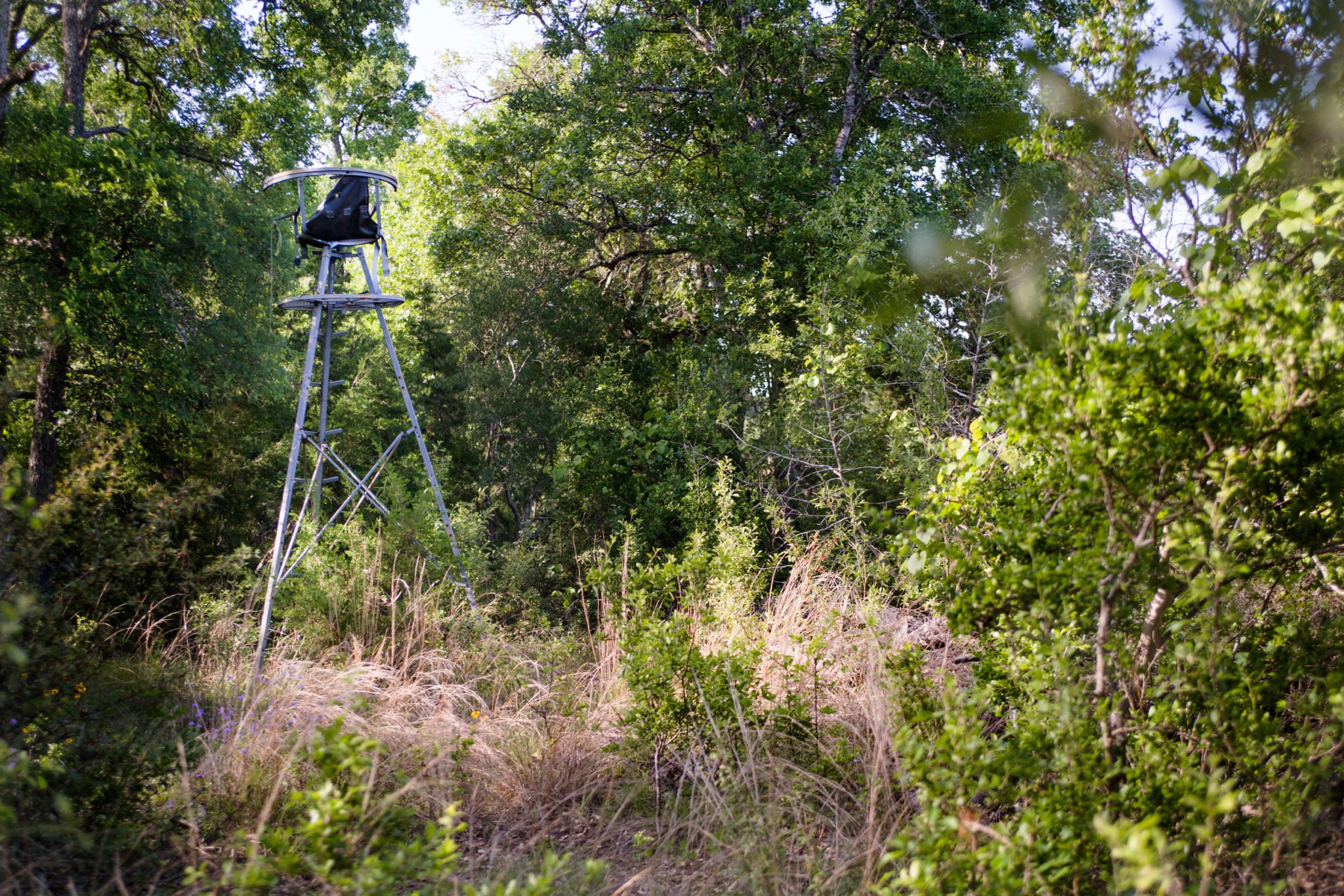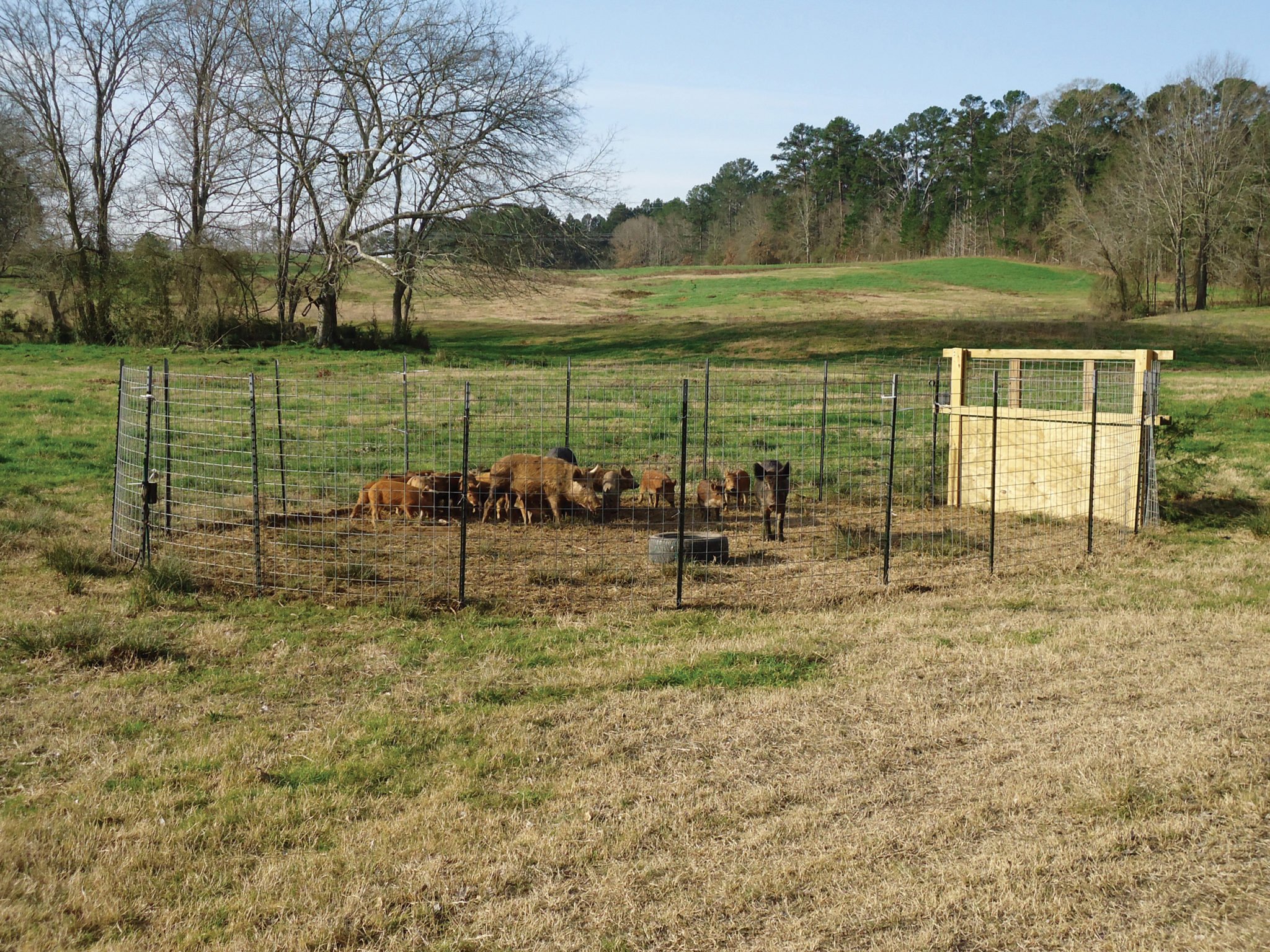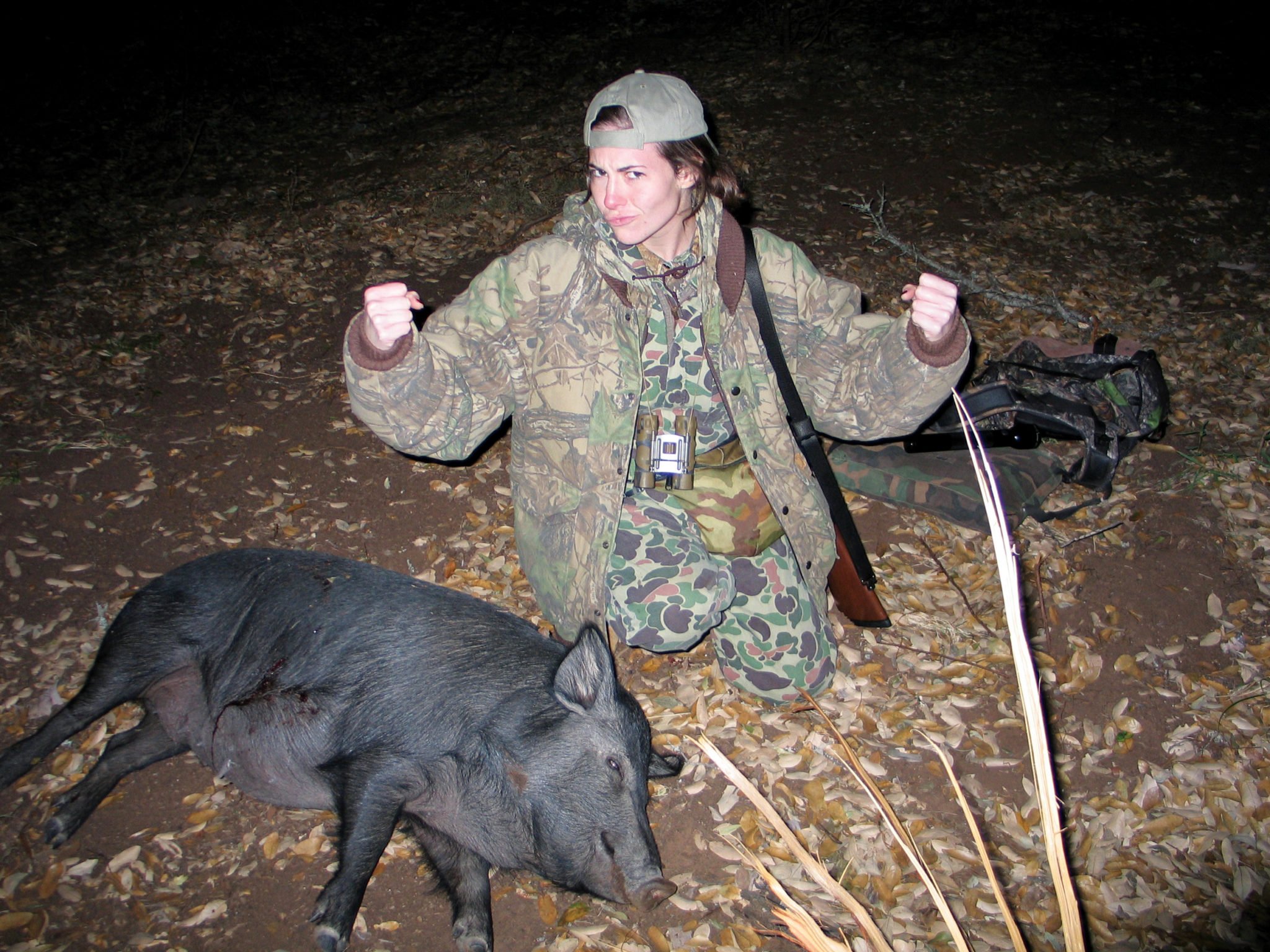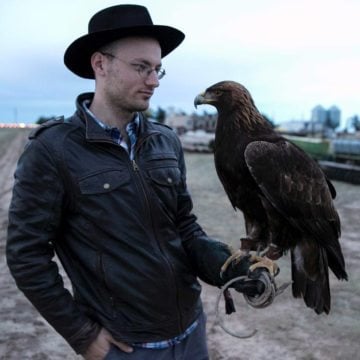Turning Tail
There’s a war on feral hogs in Texas, and the hogs are winning.
by Asher Elbein
July 24, 2017
When night falls on Storm Ranch, a 5,700-acre expanse in Dripping Springs, it falls purple and soft over fields and groves of oak and pecan. That’s when the pigs come, Josh Storm says, stealing up from the canyon bottoms and brush to root through the leaf litter. Signs of their presence appear throughout the property — broken fences, destroyed gardens, furrows dug in the grass by spade-like noses. “If I had to make a rough estimate, I’d say that there are 150, maybe 200 hogs out here,” Storm says. “They tend to come and go, on adjacent pieces of property as well. So you never really know.”
Storm is a wildlife biologist as well as a rancher, and he speaks with the kind of slow drawl made for explaining things. His property is a hunting ranch, among other things, and every year people arrive to take a shot at the hogs. They pay $100 for a day’s entry, plus $50 per hog shot, and another $50 if they don’t feel like cleaning the carcass themselves. That money is welcome income in the off-season for deer and turkey, and helps replace the broken fences and furrowed ground. By his own admission, Storm has it pretty easy: He doesn’t grow crops on his property, and the damage can be fixed. Others are not so lucky.
Consider the hog. Feral pigs are large: Adult females average 175 pounds and males reach 300 pounds or more. They breed often and in good times can raise three litters of up to 12 piglets apiece in a year. Their senses are sharp. They happily feed on anything from nuts and tubers to carrion and small animals. As anyone who has ever hunted one will tell you, they are adaptable, formidable and not easily fooled. Hogs are exciting game for sport hunting, and their ability to ingratiate themselves into human systems makes them the perfect invader.
Beginning in the 1970s, Texas sportsmen illegally — and unwisely — released wild pigs onto hunting ranches across the state. It was not the first time pigs colonized Texas — a batch had come with explorer Hernando de Soto in 1539 — but this time, for reasons that still aren’t entirely clear, the population exploded. They spread out from the ranches, sometimes foraging on supplemental feed left out for deer and pheasant, sometimes methodically working over farmland, sometimes mating with other escaped pigs. Crops of melon and rice, potato and soybean vanished. The agriculture industry reported thousands of dollars in losses, then millions. Hogs began disrupting fragile habitats in state parks. And still more arrived — trapped, trailered in and released as game. By the time state officials managed to put a stop to the practice in the ’90s, it was too late.
According to conservative estimates, there are now around 2.6 million hogs in Texas, more than anywhere else in the United States. Their foraging causes about $52 million in annual agricultural damage, and as their numbers increase they have pushed into suburban and urban areas. (Only El Paso County is thought to be clear of them, and perhaps not for long.) Agriculture Commissioner Sid Miller’s controversial attempt to poison the pigs has thrown the extent of the problem into sharp relief. Hogs in Texas have become not just a pest, but a commodity. Professional hog hunters and landowners who lease their land for hunts stand to lose if pigs are eradicated. Farmers and those suffering their depredations want them gone. And nobody knows how to get rid of them.

“It goes on indefinitely, how people are trying to make money off of feral hogs,” Will Herring says. We sit outside an Austin coffee shop in the April sunshine, watching the grackles tussle over breadcrumbs. Herring arrived dressed in mirrored sunglasses and a polo shirt, with his hair in a top knot. His main occupation is real estate law; he’s also the co-owner of Wild Boar Meat Company, a business that sells harvested pigs as pet food.
There are perhaps $20 million worth of hog traps scattered throughout the state, Herring says, with the more expensive, remotely operated models going for anywhere from $2,000 to $6,000. Trapped hogs are sold first to meat processing companies, which buy only hogs over 150 pounds at 25 to 30 cents per extra pound. From there, they’re sold to restaurants and wholesalers in America, Europe and Asia. The number of hogs slaughtered annually in Texas is upward of 700,000, Herring says. Assuming all of them are about 200 pounds, a rough estimate means that companies are buying an annual $10.5 million worth of live hogs.
Recreational hunting is another moneymaker. The very industry that helped kick-start the problem has rebranded itself — accurately — as a conservation necessity, and the chance to fight the porcine hordes with dogs, bows and guns draws hunters from across the country. The state encourages this: Pigs can be taken year-round and without limits, though a license is required. Outfitters offer armories worth of special weapons and gear, including drones fitted with thermal cameras and night-vision goggles. Specialized hunting ranches can charge around $599 for a multiday hunt; those interested in truly splurging can rent a helicopter for around $1,000 an hour. Most hogs shot this way traditionally end up in the shooter’s freezer, since animals sold for human consumption have to be inspected both before and after being slaughtered.
Nowadays, Herring and his business partner, Bryan Martin, are happy to buy them. They started the Wild Boar Meat Company in February 2016 and began any size and 40 cents per pound for gutted hogs. It’s profitable, and it helps kill pigs that otherwise might be released, which suits Herring nicely. “I want all the pigs dead,” he says. “If I were able to be semi-responsible for killing all the pigs in Texas, I’d be very, very happy. I want to put myself out of business.”
This is a fairly common refrain around hog hunting, popping up in articles, forum posts and hunting ranch websites. But with the amount of money to be made off hogs, there’s arguably a vested interest in keeping them around. And while hunting has long been the primary method of dealing with hogs, it hasn’t helped much when it comes to meaningfully decreasing their numbers. In the meantime, farmers and ranchers have been getting increasingly frustrated. “[Hogs] can push a guy from being profitable on a cotton field or a corn crop to not being profitable at all,” says state Representative Lynn Stucky, a freshman legislator and practicing veterinarian. “Currently, one of the concerns of the agriculture industry is that in spite of hunting, in spite of trapping, in spite of all these other means, they’re still losing ground.”
In situations like that it’s easy to look for a miracle cure, even if you know none is coming. Texas spends about $450,000 per year on hog control efforts, but landowners bear the brunt of the cost: The Texas Department of Agriculture estimates that citizens spend $7 million per year fighting the pigs.
There are now around 2.6 million hogs in Texas, more than anywhere else in the United States. Their foraging causes about $52 million in annual agricultural damage.
Politicians are often looking for some way to get an edge on the pigs. In 2011, state Representative Sid Miller got the “pork-chopper” bill passed, which allowed private citizens to shoot pigs from helicopters. This year, not to be outdone in the licensing of aerial killing, Representative Mark Keough offered a bill to allow the use of hot air balloons in hog hunting. But by far the most public example was an attempt this session by the Texas Department of Agriculture — now led by Sid Miller — to make an emergency rule change authorizing the use of Kaput, a poison based on a blood thinner called warfarin.
Poison has long been considered as a possible check on hogs. For the past nine years, the Texas Parks and Wildlife Department has been studying the use of sodium nitrite, which kills pigs in a matter of hours and is safe for human consumption. Kaput, on the other hand, arrived with little testing or public notice. Produced by a Colorado pest-control company called Scimetrics, it had previously been used against feral hogs in Australia. According to the proposed rules, the poison would be made available only to landowners with a license, stocked in special feeders only pigs could access, and would contain a dye that would turn their fat blue so that people wouldn’t eat poisoned meat by mistake. “With the introduction of this first hog lure,” Miller said in a statement in February, “the ‘Hog Apocalypse’ may finally be on the horizon.”
A deluge of criticism immediately hit the Texas Department of Agriculture from a variety of sources, among them Herring and Stucky. Warfarin is a slow and ugly death for anything bigger than a rat, causing internal bleeding, cramping, suffocation and aneurysms. Hogs subjected to it take two days to three weeks to die, and any scavengers that eat the meat often die too. That, more than anything, persuaded Australian authorities to ban its use. “Ranchers would go out at night and hear the pigs screaming in pain,” Herring says. “Just screaming through the night.”
There were other reasons for skepticism. The Texas Hog Hunters Association raised concerns about the possibility of people shooting and consuming poisoned hogs; many of the meat processors voiced similar worries. The ecologically minded were worried about the secondary poisoning of birds of prey, scavengers or family pets. With a single feeding station costing $1,200 and dosages around $150, even landowners who supported the use of poison questioned the cost. Others were concerned that poisoned pigs would wander onto their property, or that the poison might end up in the soil or water. However, the Texas Farm Bureau endorsed the idea, calling it “a step in the right direction to controlling the population.”
Miller and Scimetrics did little to win over critics. According to Miller, Scimetrics claimed that a product test conducted in Texas in 2015 showed an effectiveness of 97 percent, but no published studies corroborate the claim. After getting his hands on an internal report, Herring found that after setting out bait, the company had marked any hogs that disappeared as successfully poisoned, ignoring their tendency to wander off. “The whole thing is incredibly frustrating,” Herring says. “These people were in the rat poison business. I think they saw an opportunity and rushed to get [Kaput] labeled so they could beat sodium nitrite to market.”
Within a week of Miller’s announcement, the Wild Boar Meat Company, Texas Hog Hunters Association and the Environmental Defense Fund successfully sued to block the rule change. Around the same time, Stucky co-sponsored a bill requiring that Kaput be properly studied before being authorized for wide use; it sailed through the House on a 127-12 vote. (Perhaps in a sign of the Legislature’s mood, state Representative Jonathan Stickland’s biennial attempt to strip money from state hog control during a budget debate immediately resulted in a counter-amendment defunding the highways through his hometown. It overwhelmingly passed.)
Noting the change in the wind, Scimetrics withdrew its attempt to get state registration for Kaput on April 25, citing the potential of future lawsuits. Stucky told the Dallas Morning News that he was happy Scimetrics had stepped back. Miller, who declined to be interviewed for this story, blamed “politically correct urban media hacks and naysayers” for the withdrawal.


The fact of the matter is that Texas is not only stuck with its feral hogs, it can only make a dent in their numbers. According to Billy Higginbotham, wildlife and fisheries specialist with Texas A&M AgriLife Extension Service and something of a state authority on pigs, hunting and trapping certainly helps: An A&M study found the combination reduced annual damage by as much as 66 percent. But such techniques have to be deployed widely and consistently. Clear the hogs from one patch of land and they’ll flow in from another; stop hunting them and their numbers will rebound in a year. But consistency is difficult to accomplish in Texas. Even if we had a poison we could use alongside hunting tomorrow, hogs will never be eradicated in the state, Higginbotham says. “You’re gonna have some that would elect to use the toxicant and some that won’t,” he says. “You have landowners today who’ll shoot and trap pigs, and landowners who won’t. That’s not gonna change with poison. You have to use it everywhere.”
There is also the fact that there are plenty of people in the state who still benefit from the pigs’ presence — not just hunters, but some landowners as well. “It’s a thriving industry,” Higginbotham says. “It’s not just the people taking a problem and turning it into a protein source, but also landowners who elect to allow hunting are making a profit. And the meat industry has grown. Both of these have grown as the pig problem has increased. … We’ve got people who are benefiting from wild pigs that don’t want to see them eradicated.”
Tying hog control efforts to financial incentives is an inherently dicey proposition. Hunting and trapping do offer a generally effective method for keeping pig numbers down. But in the absence of a unified approach, the state has to rely on the feral hog industry to manage a problem it had a hand in creating. Pigs are still released on hunting ranches and still raise healthy litters on the corn supplements set out for game. All the while, farmers and ranchers continue to bear the brunt of the damage, their ruined crops fattening the pigs that the industry profits from. If hog hunting suddenly becomes less popular, or if the price of pig meat falls sharply, the hunting and meat industry might slacken, allowing the population to surge. Without a clear solution, the war on hogs continues to drag on.
“We have an army and we have the battlefield, and nobody’s figured out a way to match them up.”
Still, Herring is guardedly optimistic about getting everyone on the same page. “Landowners don’t want just any and everyone out there blowing holes in their barns and tractors, tearing through their roads, messing up their fields,” he says. “But there’s a lot of people that do want to shoot pigs, and will spend their life’s savings on equipment to go pig hunting. You can shoot ’em all year round. They’re the best animal to hunt, if you like to hunt. We have an army and we have the battlefield, and nobody’s figured out a way to match them up.”
One such battleground lies off a nearly imperceptible path at Storm Ranch, down a grassy strip bordered by a wire fence on one side and a low wall of stacked limestone chunks on the other. Between them a corn dispenser stands out in the open, the ground beneath its metal legs scattered with dry kernels. Thirty feet or so from the feeder sits a simple blind. Sometimes, when night falls and the pigs are in the neighborhood, they wander up from the bottoms and eat the corn. Sometimes a shot rings out from the nearby blind or a chair. A pig falls; sometimes two or three.
It doesn’t matter. They always come back.
Opening photo: A feral hog’s portrait is captured in 2015 by a sensor-triggered camera placed in a creek bottom in Atascosa County. Photo by Casey Smartt
This article appears in the June 2017 issue of the Texas Observer. Read more from the issue or become a member now to see our reporting before it’s published online.




